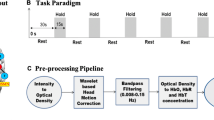Abstract
In late age, the autonomic nervous system (ANS) has diminished ability to maintain physiological homeostasis in the brain in response to challenges such as to systemic blood pressure changes caused by standing. We devised an fMRI experiment aiming to map the cerebral effects of an ANS challenge (Valsalva manoeuvre (VM)). We used dual-echo fMRI to measure the effective transverse relaxation rate (R2*, which is inversely proportional to brain tissue oxygenation levels) in 45 elderly subjects (median age 80 years old, total range 75–89) during performance of the VM. In addition, we collected fluid-attenuated inversion recovery (FLAIR) data from which we quantified white matter hyperintensity (WMH) volumes. We conducted voxelwise analysis of the dynamic changes in R2* during the VM to determine the distribution of oxygenation changes due to the autonomic stressor. In white matter, we observed significant decreases in oxygenation levels. These effects were predominantly located in posterior white matter and to a lesser degree in the right anterior brain, both concentrated around the border zones (watersheds) between cerebral perfusion territories. These areas are known to be particularly vulnerable to hypoxia and are prone to formation of white matter hyperintensities. Although we observed overlap between localisation of WMH and triggered deoxygenation on the group level, we did not find significant association between these independent variables using subjectwise statistics. This could suggest other than recurrent transient hypoxia mechanisms causing/contributing to the formation of WMH.



Similar content being viewed by others
Abbreviations
- ACA:
-
Anterior artery perfusion territory
- ANS:
-
Autonomic nervous system
- BOLD:
-
Blood oxygenation level dependent
- CBF:
-
Cerebral blood flow
- EPI:
-
Echo planar imaging
- GLM:
-
General linear model
- GM:
-
Gray matter
- HWGFS:
-
Half-width of the gamma function smoothing of the input waveform
- MCA:
-
Medial cerebral artery territory
- R2*:
-
Effective transverse relaxation rate
- TE:
-
Echo time
- TR:
-
Repetition time
- VM:
-
Valsalva manoeuvre
- WM:
-
White matter
- WMH:
-
White matter hyperintensities
References
Ashburner J, Friston KJ (2005) Unified segmentation NeuroImage 26:839–851. doi:10.1016/j.neuroimage.2005.02.018
Caine D, Watson JD (2000) Neuropsychological and neuropathological sequelae of cerebral anoxia: a critical review. J Int Neuropsychological Soc: JINS 6:86–99
Dawson SL, Panerai RB, Potter JF (1999) Critical closing pressure explains cerebral hemodynamics during the Valsalva maneuver. J Appl Physiol 86:675–680
Debette S, Markus HS (2010) The clinical importance of white matter hyperintensities on brain magnetic resonance imaging: systematic review and meta-analysis. BMJ 341:c3666. doi:10.1136/bmj.c3666
Feihl F, Liaudet L, Levy BI, Waeber B (2008) Hypertension and microvascular remodelling. Cardiovasc Res 78:274–285. doi:10.1093/cvr/cvn022
Fernando MS et al (2006) White matter lesions in an unselected cohort of the elderly: molecular pathology suggests origin from chronic hypoperfusion injury Stroke; a journal of cerebral circulation 37:1391–1398. doi:10.1161/01.STR.0000221308.94473.14
Ferrer I, Kaste M, Kakiko H (2008) In: Love S, Louis DN, Ellison D. (eds) Greenfield’s Neuropathology, vol 1. Hodder Arnold Publication, p 128
Firbank MJ, Minett T, O'Brien JT (2003) Changes in DWI and MRS associated with white matter hyperintensities in elderly subjects Neurology 61:950–954
Galluzzi S et al (2009) Cardiac autonomic dysfunction is associated with white matter lesions in patients with mild cognitive impairment. J Gerontol A: Biol Med Sci 64:1312–1315. doi:10.1093/gerona/glp105
Glover GH, Lemieux SK, Drangova M, Pauly JM (1996) Decomposition of inflow and blood oxygen level-dependent (BOLD) effects with dual-echo spiral gradient-recalled echo (GRE) fMRI. Magnetic Resonance Med: Off J Soc Magnetic Resonance Med/Soc Magnetic Resonance Med 35:299–308
Grueter BE, Schulz UG (2012) Age-related cerebral white matter disease (leukoaraiosis): a review Postgrad Med J 88:79–87. doi:10.1136/postgradmedj-2011-130307
He J, Hollingsworth KG, Newton J, Blamire AM (2013) Cerebral vascular control is associated with skeletal muscle pH in chronic fatigue syndrome patients both at rest and during dynamic stimulation. Neuroimage: Clin 2:168–173
Henderson LA et al (2002) Brain responses associated with the Valsalva maneuver revealed by functional magnetic resonance imaging. J Neurophysiol 88:3477–3486. doi:10.1152/jn.00107.2002
Henderson LA et al (2003) Neural responses during Valsalva maneuvers in obstructive sleep apnea syndrome. J Appl Physiol (1985) 94:1063–1074. doi:10.1152/japplphysiol.00702.2002
Hotta H, Uchida S (2010) Aging of the autonomic nervous system and possible improvements in autonomic activity using somatic afferent stimulation. Geriatrics Gerontology Int 10(Suppl 1):S127–136. doi:10.1111/j.1447-0594.2010.00592.x
Jenkinson M, Bannister P, Brady M, Smith S (2002) Improved optimization for the robust and accurate linear registration and motion correction of brain images. NeuroImage 17:825–841
Kalaria RN (2010) Vascular basis for brain degeneration: faltering controls and risk factors for dementia. Nutr Rev 68(Suppl 2):S74–87. doi:10.1111/j.1753-4887.2010.00352.x
Kerr SR, Pearce MS, Brayne C, Davis RJ, Kenny RA (2006) Carotid sinus hypersensitivity in asymptomatic older persons: implications for diagnosis of syncope and falls. Arch Intern Med 166:515–520. doi:10.1001/archinte.166.5.515
Lanterna LA, Lunghi A, Martchenko S, Gritti P, Bonaldi G, Biroli F (2011) Cerebral watershed hypoperfusion in subarachnoid hemorrhage: computed tomography perfusion analysis. J Neurosurg 114:961–968. doi:10.3171/2010.8.JNS091766
Mandell DM, Han JS, Poublanc J, Crawley AP, Kassner A, Fisher JA, Mikulis DJ (2008) Selective reduction of blood flow to white matter during hypercapnia corresponds with leukoaraiosis. Stroke J Cerebral Circ 39:1993–1998. doi:10.1161/STROKEAHA.107.501692
Mangla R, Kolar B, Almast J, Ekholm SE (2011) Border zone infarcts: pathophysiologic and imaging characteristics. Radiographics: Rev Publ Radiological Soc North Am Inc 31:1201–1214. doi:10.1148/rg.315105014
Meyer JS, Gotoh F, Takagi Y, Kakimi R (1966) Cerebral hemodynamics, blood gases, and electrolytes during breath-holding and the Valsalva maneuver. Circulation 33:II35–48
Newton JL et al (2008) Cognitive impairment in primary biliary cirrhosis: symptom impact and potential etiology. Hepatology 48:541–549. doi:10.1002/hep.22371
O'Sullivan M (2008) Leukoaraiosis Practical neurology 8:26–38. doi:10.1136/jnnp.2007.139428
Pantoni L (2002) Pathophysiology of age-related cerebral white matter changes. Cerebrovasc Dis 13(Suppl 2):7–10
Perlmuter LC, Sarda G, Casavant V, Mosnaim AD (2013) A review of the etiology, asssociated comorbidities, and treatment of orthostatic hypotension. Am J Ther 20:279–291. doi:10.1097/MJT.0b013e31828bfb7f
Pfefferbaum A, Chanraud S, Pitel AL, Shankaranarayanan A, Alsop DC, Rohlfing T, Sullivan EV (2010) Volumetric cerebral perfusion imaging in healthy adults: regional distribution, laterality, and repeatability of pulsed continuous arterial spin labeling (PCASL). Psychiatry Res 182:266–273. doi:10.1016/j.pscychresns.2010.02.010
Richardson J, Kerr SR, Shaw F, Kenny RA, O’Brien JT, Thomas AJ (2009) A study of orthostatic hypotension in late-life depression. Am J Geriatric Psychiatry: Off J Am Assoc Geriatric Psychiatry 17:996–999. doi:10.1097/JGP.0b013e3181b4bf35
Rodriguez G et al (1991) Regional cerebral blood flow asymmetries in a group of 189 normal subjects at rest. Brain Topogr 4:57–63
Shen J (2005) https://www.mathworks.co.uk/matlabcentral/fileexchange/8797-tools-for-nifti-and-analyze-image
Smith SM (2002) Fast robust automated brain extraction. Hum Brain Mapp 17:143–155. doi:10.1002/hbm.10062
Smith SM et al. (2004) Advances in functional and structural MR image analysis and implementation as FSL NeuroImage 23 Suppl 1:S208–219. S1053-8119(04)00393-3 [pii] doi:10.1016/j.neuroimage.2004.07.051
Smith SM, Brady JM (1997) SUSAN - a new approach to low level image processing. J Comput Vision 23:45–78
Taylor D (1996) The Valsalva manoeuvre: a critical review. Underwater Med Soc 26:8–13
Topakian R, Barrick TR, Howe FA, Markus HS (2010) Blood–brain barrier permeability is increased in normal-appearing white matter in patients with lacunar stroke and leucoaraiosis. J Neurol Neurosurg Psychiatry 81:192–197. doi:10.1136/jnnp.2009.172072
Waldstein SR, Siegel EL, Lefkowitz D, Maier KJ, Brown JR, Obuchowski AM, Katzel LI (2004) Stress-induced blood pressure reactivity and silent cerebrovascular disease. Stroke J Cerebral Circ 35:1294–1298. doi:10.1161/01.STR.0000127774.43890.5b
Wardlaw JM, Sandercock PA, Dennis MS, Starr J (2003) Is breakdown of the blood–brain barrier responsible for lacunar stroke, leukoaraiosis, and dementia? Stroke J Cerebral Circ 34:806–812. doi:10.1161/01.STR.0000058480.77236.B3
Wentland AL, Rowley HA, Vigen KK, Field AS (2010) Fetal origin of the posterior cerebral artery produces left-right asymmetry on perfusion imaging. AJNR Am J Neuroradiology 31:448–453. doi:10.3174/ajnr.A1858
Woolrich MW et al. (2009) Bayesian analysis of neuroimaging data in FSL NeuroImage 45:S173–186. S1053-8119(08)01204-4 [pii] doi:10.1016/j.neuroimage.2008.10.055
Acknowledgments
The research was funded by the National Institute for Health Research (NIHR) Newcastle Biomedical Research Centre based at Newcastle upon Tyne Hospitals NHS Foundation Trust, the British Geriatric Society and Research into Ageing Fund; a fund set up and managed by Age UK. The views expressed are those of the authors and not necessarily those of the NHS, the NIHR or the Department of Health. The authors are grateful to Dr. Michael Firbank (Newcastle University) for providing us with his code for WMH segmentation and guidelines for its usage and Dr. Andreas Finkelmeyer (Newcastle University) for his valuable comments and advice.
Author information
Authors and Affiliations
Corresponding author
About this article
Cite this article
Bohr, I., McDonald, C., He, J. et al. Brain oxygenation responses to an autonomic challenge: a quantitative fMRI investigation of the Valsalva manoeuvre. AGE 37, 91 (2015). https://doi.org/10.1007/s11357-015-9833-6
Received:
Accepted:
Published:
DOI: https://doi.org/10.1007/s11357-015-9833-6




